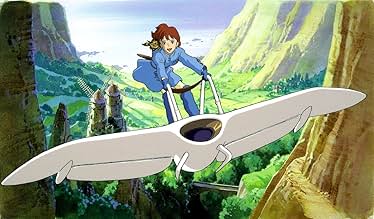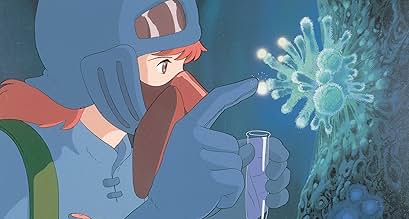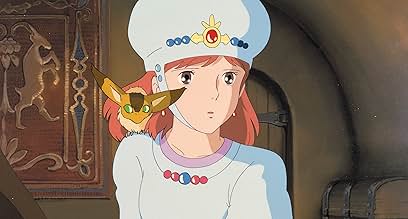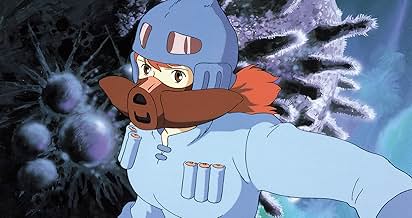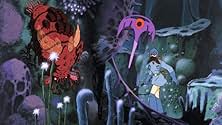A princesa Nausicaä luta desesperadamente para impedir que duas nações em guerra se destruam e destruam seu planeta moribundo.A princesa Nausicaä luta desesperadamente para impedir que duas nações em guerra se destruam e destruam seu planeta moribundo.A princesa Nausicaä luta desesperadamente para impedir que duas nações em guerra se destruam e destruam seu planeta moribundo.
- Direção
- Roteiristas
- Artistas
- Prêmios
- 3 vitórias e 1 indicação no total
- Nausicaä
- (narração)
- Jihl
- (narração)
- …
- Oh-Baba
- (narração)
- Mito
- (narração)
- Goru
- (narração)
- Gikkuri
- (narração)
- Niga
- (narração)
- Teto
- (narração)
- …
- Girl A
- (narração)
- Girl B
- (narração)
- Boy A
- (narração)
- Asbel
- (narração)
- Rastel
- (narração)
- Mayor of Pejite
- (narração)
- (as Makoto Terada)
- Rastel's Mother
- (narração)
- Kushana
- (narração)
Avaliações em destaque
I tracked down a copy of the VHS and sent it to my young nieces, pleased with a "kid's" movie which provided a positive role model without being dumb. The movie captivated them as well -- they wore the tape out, and it started them on a lifelong interest in anime. It was they who sent me the uncut subtitled version years later, completing the circle.
Nausicaa is decent science fiction, often breath-taking animation, and unusually *human* characters, and every time I see it I am glad I returned. Everyone should give it a chance, especially those who have written off anime as "round eyed kids and lots of explosions".
Although the incredible "Princess Mononoke" later upstaged this early work in terms of art and detail, in many ways I still prefer "Nausicaa". Its imaginitive and well-conceived world puts me in mind of Dune with its feuding factions, its giant creatures, and its strong ecological message. Even with a rather long running time, the story moves very briskly (boiled down as it was from a very lengthy manga series). The music deserves special mention, as well, as it is a large step up from the electronic pop stylings of most anime.
If you can get your hands on a copy of the original version, you'll find it more than worth the effort.
Nausicaä, which is based on Miyazaki's gargantuan Manga series, is set in the distant future, after fires destroyed much of the earth. The world is being consumed by the Sea of Decay, a toxic forest that spreads through airborne spores and is protected by giant insects called ohmu. The Valley of the Wind is one of the last pure places on earth, and its Princess, Nausicaä, is a strong-willed yet free-spirited young woman seeking to solve the mystery of the Sea of Decay. A nearby nation, which claims to have harnessed the power that allowed humans to rule the earth a thousand years before, takes over after a plane carrying a mysterious living cargo crashes in the valley. What follows in the film is a struggle, not of good versus evil, but of man versus nature. The story is complex, as is its message, and Miyazaki has ingeniously spun deep complexities into the animated characters: what look like foes may not be, and what look like friends may be a bit more dangerous.
The animation is colorful, sweeping, expansive, and beautiful, as are the plot and characters. There is an immediacy to the story that makes a big emotional impact and makes us question how we handle our position in nature. As one of the characters in the film asks, have humans become but a tribe destined to be swallowed by the Sea of Decay? It is ultimately a film about compassion in the face of violence and war, which is what makes it so different from Western features.
Disney's recent DVD release is excellent. The film can be watched either in the original Japanese audio or Pixar's dub with Patrick Stewart and Uma Thurman, and there are separate subtitles for each language track--a literal one (hallelujah!) for the Japanese track, and a more closed-captions style set for the English track. The film is so stunning in the Japanese that I have never considered watching the dub, though a fellow film buff has said that it is "not so bad." After this film was released in the US in the 1980s in a completely mangled version called Warriors of the Wind, Miyazaki suspended all US rights of all his other films until the distributor would honor the stipulation that they be released without any editing. The fact that Disney, which is known for watering down nearly everything it touches, has done this with such a non-Western-style movie is amazing.
In this early full length film he really got to spread his wings. There are fantastic aerial sequences like the jet-glider evading the flying snakes, which (this predates computed 3D, and aerial sequences are present in most of his work) are just a tour-de-force of imagination and geometry. And yet this is a world that feels very organic, not geometric, with a cast of characters drawn in a unique cross between hobo, samurai, and pirate - totally blending in to an imaginary post apocalyptic world where humans scratch out a precarious life in villages hidden in the few green valleys left in a world of desert, where the only remaining resources are wind, sunlight, and humans.
But it is also a world of enormous dangers, including airborne bandits and the strange, mutated creatures that have evolved to control the barren and scarred earth. When our heroine's valley home is attacked by raiders, she embarks on an adventure against them that will lead her, and some unlikely allies found along the way, to an eventual confrontation combining warring armies of bandits, ancient machines of infernal destruction, and the implacable, mysterious, threatening beasts which roam the badlands. The pace is swashbuckling - if this were a book, it would be one you could not stop reading.
It has the feel of the original comic books, but plays out wonderfully on the screen - you don't need to know the comics. The style is very unique. Even though it is very stylized (no photorealism here), you immediately get the feeling of the world and the characters. The story works for children of all ages (mine both first saw this before they were 6, and have memorized it long since), and combined with the wonderful visuals it is a treat for adults too. As a genre I would classify it as soft (no attempt at scientific correctness) sci-fi rather than fantasy, though some might think it more a work of fantasy. It is fascinating partly because its roots in style and action are unexpected for a western viewer. Japanese manga and stories had evolved in their own way, and although this is early Miyazake, it is already a product of that mature and distinct art form.
As always with Miyazake - if you haven't seen his work, well you haven't seen anything like it, and it is time you did.
Technically not a Ghibli film (Miyazaki actually used the studio which did most of 'The Last Unicorn', and which more or less became Ghibli when 'Laputa' was made a couple of years later), 'Nausicaa' is a far-future SF story with a princess/warrior/nature-lover heroine and strong environmental themes. There's also an opposing princess/leader trying to use technology to overcome the apparently hostile environment. If you're starting to think 'Princess Mononoke', you'd be on the right track. In some ways 'Nausicaa' seems like an early stab in the direction of 'Mononoke', though the latter would delve far more into spirituality and mythology, eschewing the SF aspects.
There aren't really any major weak points in Nausicaa - unless you count the frustrating 12 drawings per second animation which I constantly complain about in Japanese animation. The backgrounds aren't as amazing and the animation not as good as the last few Ghibli films, but for 1984 it was plenty good enough. I have a fairly trivial complaint in that the character of Kuratowa is drawn in a slightly more 'anime' style, ala Lupin III, whereas all of the other characters are done in a realistic style. He just seems a little out of place, though he's quite delightfully drawn.
The really strong points of the movie are its pacing (at least until the very end. Miyazaki was unhappy with the end too), its story telling, which manages to be sophisticated without being impossibly complex, its engrossing background drawings and settings, - and most of all in the amazing attention to detail in the fully realized post-apocalypse SF-fantasy world in which the story is set. Every little thing is worked out and placed such that you find yourself admiring inventions, ideas, structures, creatures, etc which don't draw attention to themselves, but simply exist as part of the backdrop of the movie. Of course 'Nausicaa' had existed for several years as a serialised Manga, so Miyazaki no doubt knew its universe inside-out.
There's a very clever plot, which I won't give away, but which involves humanity's relationship with the Earth and nature.
It's the sort of movie which you can get thoroughly caught up in, and which will stand repeated viewings. It really is a film which is perfectly pitched at both a young and an adult audience. As Miyazaki's second feature film it is also, rightly or wrongly, usually considered the start of Studio Ghibli, and is arguably worth watching for historical reasons, too.
Not the very best from Miyazaki or Ghibli, but an auspicious beginning.
PS, in case you didn't know, there was a heavily butchered US version floating around called 'Warriors of the Wind', which is universally reviled as a disgrace. Just to make it confusing, some of the Japanese copies are also called 'Warriors of the Wind'. The thing to look for is the 116 minute running length. If you get that, you've got the right one. At the moment the only way you can get the film is in Japanese dialog with English subtitles. Personally I'd go ahead and do that, rather than wait while Disney squats on the US distribution rights (Amazon gives it a release date of 2010 for God's sake). You can always replace it later.
Good stuff.
Você sabia?
- CuriosidadesWhen Nausicaä was first released as an English dub in the U.S. in 1985 it was drastically cut down to 1 hour and 35 minutes and titled Warriors of the Wind. Writer and Director Hayao Miyazaki was still so upset by the truncated "Warriors of the Wind" version of Nausicaä that when Harvey Weinstein approached him to discuss the distribution to his following film Princesa Mononoke (1997) and insisted on a similar heavily cut version of the movie, Miyazaki angrily left the meeting. Several days later, Studio Ghibli producer Toshio Suzuki sent a katana sword to Weinstein's office with "NO CUTS" embedded into its blade. The movie was later released in the U.S. in its uncut version. During a later interview, Miyazaki commented on the incident by smiling and stating, "I defeated him." Nausicaä was his only film to suffer heavy editing on first release. In 1995 the US rights returned to Miyazaki and he made a distribution deal with Disney. In 2003 a new English dub with Patrick Stewart and Uma Thurman was released in the uncut 117 minute (1hr 57min) version. - James LaPierre WUD Films
- Erros de gravaçãoDuring the climactic battle scene, the design of Oh-Baba's headband changes several times. It sometimes has gold beads instead of gold-circled turquoise beads on the end-pieces, and alternately terminates with a single or a double line of cord.
- Citações
Nausicaä: Every one of us relies on water from the wells, because mankind has polluted all the lakes and rivers. but do you know why the well water is pure? It's because the trees of the wastelands purify it! And you plan to burn the trees down? You must not burn down the toxic jungle! You should have left the giant warrior beneath the earth!... Asbel, tell them how the jungle evolved and how the insects are gaurding it so we won't pollute the earth again. Asbel please!
- Cenas durante ou pós-créditosAs the credits roll we see life returning to normal in the valley: Kushana, Kurotowa and the Tolmekian fleet leave peacefully, after Nausicaä has unheard words for Kushana. The denizens of the Valley of the Wind replant trees in the burned-down forest. Lord Yupa and Asbel ride Yupa's beasts to the Toxic Jungle and explore it. When the text "The End" appears on screen we see Nausicaa's discarded helmet in the forest, alongside a green, non-Toxic Jungle sapling.
- Versões alternativasIn the original Japanese version of the film, a World Wildlife logo praising the film is displayed at the beginning. For the US release from Disney, this logo was replaced with a typical Studio Ghibli logo.
- ConexõesEdited into Tales of the Valley of the Wind (2009)
- Trilhas sonorasKaze no Tani no Naushika (Symbolic Theme Song)
Lyrics by Takashi Matsumoto
Music by Haruomi Hosono
Arranged by Mitsuo Hagita
Vocals by Narumi Yasuda (Tokuma Japan)
Principais escolhas
Detalhes
Bilheteria
- Orçamento
- US$ 1.000.000 (estimativa)
- Faturamento bruto nos EUA e Canadá
- US$ 495.770
- Faturamento bruto mundial
- US$ 9.095.773
Contribua para esta página








